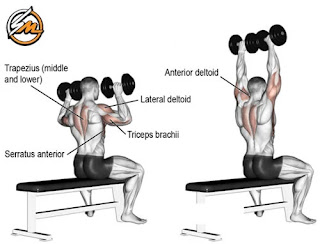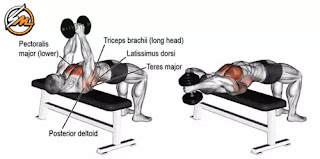Strength training with compact fitness dumbbells, with variable-load dumbbells, and in general, all strength-training exercises with free weights (as opposed to guided-load machines), ensure complete and functional strengthening and improvement of the condition. physical thanks to the participation of the stabilizing annex muscles. Dumbbells are therefore the perfect equipment for complete bodybuilding at home. Our program of 15 exercises to do at home and the notebook that accompanies it as well as our 5 complex sequences will allow you to follow an effective workout for your arms and shoulders but also your pectorals, your glutes, your thighs, and your back.
Benefits of weight training with dumbbells
In addition to the small size of the dumbbells compared to guided weight machines, the advantage of using small dumbbells to do your weight training exercises at home is the certainty of performing a completely natural movement that will respect human anatomical characteristics. and in particular the axes of rotation of the joints. For more details on this subject, you can consult the article "Dumbbells or machines in bodybuilding" on the site Fitadium.com
The increased requirement to stabilize the whole body during movement is reflected in an effort of proprioception and maintenance carried out by numerous ancillary muscles. This effort, far from penalizing the practitioner, is the guarantee of a fast and complete musculation and more efficient training.
Instability can even be increased by using a gym ball as a back or buttock support. To increase the qualities of power and explosiveness, it is relevant to combine, in the same exercise, dumbbells, and an elastic fitness band. While learning the different exercises requires a longer time to know how to do them without risk of injury compared to exercises with guided loads, but the total gain in strength and tone largely deserves this additional time. The old photo below is not, on this subject, an example to follow ... In summary, the work is richer and more complete because the movement is more complex.
14 Best Dumbbell Exercises for Building Muscle
1 - Dumbbell Concentration Curl
The concentration curl works the biceps. In a seated position with legs apart and feet flat on the ground, lean forward and place your right hand on the right thigh. You then wedge your left triceps against the inside of your left thigh. The dumbbell is supinated (palm up) in your left hand. The arm is very slightly bent. Bend it and raise the dumbbell until it touches the chest. A pause is marked, then you return to the starting position. Only the forearm moves by the contraction of the biceps. The rest of the body is perfectly still. We change sides when the series is over.
2 - Dumbbell Hammer Curl
The concentrated curl works the biceps and the muscles of the forearm but also, and above all, the anterior brachialis and the long supinator. With two dumbbells, alternately or simultaneously bend the elbows, keeping them tight near the bust. Hands are in neutral grip with thumbs facing up (hammer grip). The back is straight and the feet are shoulder-width apart. The arm is never fully extended. The bust does not swing back and forth or left to right. It remains fully sheathed with the shoulders in a low position.
3 - Seated Dumbbell Triceps Extension
The arm extension works the triceps brachii in isotonic contraction, the trapezius, and the deltoid in strong isometric contraction. From the seated position with the arm moving the dumbbell stretched over the head and the shoulder free, bend the forearm to lower the dumbbell in neutral or hammer grip (thumbs facing up) behind the head without going off-center. The load should take the direction of the scapula on the same side. We stop the movement before contact on the neck. The arm remains permanently vertical with the elbow pointing upwards. The back is propped up by the back of the chair, but there should also be no lateral torso rotation or flexion. This exercise can be performed while standing. The static hold requirements remain the same. The bust is then no longer supported on the slightly oblique but vertical backrest and sheathed as in the previous exercise.
4 - Dumbbell Kickback
The kickback uses the three bundles of the triceps brachii in isotonic contraction (creation of movement) and the posterior bundles of the deltoid in isometric contraction (static support of the upper limb with the arms horizontal). The knee and hand on the same side are resting on a bench. The dumbbell is held with the other hand in a hammer grip. The arm holding the load is horizontal and forms an angle of 90 ° with the forearm. Full rear extension of the forearm causes horizontal alignment of the upper limb. This full amplitude and alignment must be effective at each repetition which requires permanent sheathing of the shoulder at the deltoid level. The back is always flat and the shoulders remain parallel to the ground. The rear extension should not be accompanied by a reflex rotation and an upward opening of the torso. Finally, a slow and controlled pace, as well as a pause of one second during the final extension, are preferable to a fast and incomplete execution speed.
5 - Seated Dumbbell Press
The seated press with dumbbells is also called military press or dumbbell shoulder press. It can be performed with a single dumbbell which increases the lateral stabilization effort because you do not have to sway during the extension of the arms. Deltoids and upper fibers of the trapezius are stressed during this exercise. The feet flat and wide apart stabilize the pelvis. the bust is straight and sheathed. It is not mandatory to keep both dumbbells aligned on the same plane during their ascent. It is certainly necessary to open the chest and orient the inside of the elbows forward, but the rotation of the shoulders must follow its natural anatomical amplitude. This is one of the advantages of dumbbells over the weightlifting bar, the movement of which is more restrictive for the joints.
6 - Dumbbell Front Raise
The frontal elevation with dumbbells or dumbbell front raise mainly solicits the front of the shoulder, the anterior bundles of the deltoids, and the upper part of the pectorals. You can alternate the gesture to the right and the left or perform it simultaneously. The manual grip is either overpronation with the back of the hand pointing upwards, or neutral grip (easier with thumbs facing up). The goal is to raise the dumbbells slightly above the horizontal line through the shoulders. You do not have to swing your body to lift the loads. The bust is straight and sheathed, the legs and arms remain permanently stretched. The pace of execution is slow with a pause in the high position. It is necessary to master the descent of the arms and not to release the muscular tension. This return to the bottom represents an eccentric muscular effort.
7 - Dumbbell Lateral Raise
The lateral raise with dumbbells or dumbbell lateral raise allows you to increase the build by soliciting the deltoid. It can be alternated unilateral (we lift the right dumbbell alternately then the left dumbbell) or simultaneous bilateral (we lift both dumbbells at the same time. This exercise works the deltoid (middle / outer portion), the trapezius (upper beam). and the rotator cuff of the shoulder (especially supraspinatus and supraspinatus muscles). The palms of the hands are facing down. The arms can be slightly bent but not more than a 45 ° angle. above all, avoid tilting the torso back and forth during the ascent of the loads. A slight flexion-extension of the legs is possible to facilitate the work of the upper limbs but we then place ourselves in a poly-articular functional approach. The objective is to specifically strengthen the shoulders (work in isolation). You should never bend your legs.
8 - Dumbbell Flys
The dumbbell flys or butterfly is a simultaneous separation of the arms carried out lying on a bench or sitting on a multi-function device to strengthen the pectorals. The exercise begins with neutral weight gain, arms straight and upright. We descend slowly by spreading the arms and bending them slightly. As soon as an unpleasant tension is felt, the movement is stopped. We then bring our arms together and stretch them out to find the starting position. The butterfly can also be performed on an inclined bench. The sternal and clavicular parts of the pectorals are thus more stressed.
9 - Dumbbell Bench Press
For the bench press, the dumbbells can be taken in pronation, but the neutral position (hammer) is more respectful of the anatomical characteristics. The bench press mainly involves the pectoralis major and pectoralis minor. It also involves the triceps and the front of the shoulders (the anterior deltoids). The lying position is less stable than with a weightlifting bar; the stabilizing muscles are the serrated ones because they attach the shoulder blades to the rib cage. The descent stops when the dumbbells are on either side of the torso.
10 - Dumbbell Pullover
To make the pullover properly, you must firmly grip only one of the two discs. The legs stabilize the body throughout the movement by providing pressure on the ground. If the arms were bent at the start of the closure, which is almost always the case, the movement is finished by stretching them upwards as much as possible and pushing the load back with the shoulders to maximize the work of the large serratus anterior.
11 - Dumbbell Squat
The dumbbells are held at arm's length like suitcases or placed on the shoulders. The shoulders are as relaxed as possible. The arms do not swing and remain vertical just like the bust. The gaze is horizontal. Do not try to make the dumbbells touch the ground by rounding the back and tilting the shoulders at the end of the leg curl. Descent and ascent are carried out while keeping the torso vertical. There are a lot of variations for the squat.
12 - Dumbbell Front Lunge
By increasing the amplitude of the forward lunge we accentuate the work of the glutes and we reduce that of the quadriceps. The front lunge is one of the 13 exercises that we have selected to have firm and shapely buttocks
13 - Dumbbell Row
Support on the bench secures the back. The knee and hand which provide this support place the back on a low oblique angle close to 30 °. The dumbbell is vertical to the shoulder at the start of the pull-up. It is directed towards the hip. The bust remains straight and does not begin to rotate during the rise of the load.
14 - Dumbbell Reverse Fly
The inverted butterfly strengthens, like the row on the bench, the rhomboids, and the deltoids. He also avoids having around and arched back. It is carried out sitting very inclined bust; it must remain straight with the head in its extension, therefore without extension. The stomach should not be compressed. The load should be moved up to the horizontal line passing through the shoulders, keeping the arms almost straight. The weights moved must always allow a technically compliant execution without straightening of the torso
Related article: Top 5 Dumbbell Exercises For Building Strength





















0 Comments